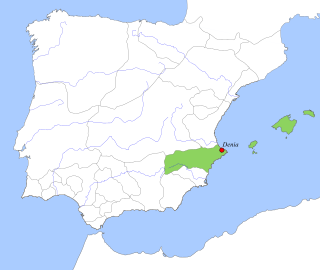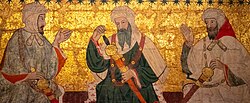
The taifas were the independent Muslim principalities and kingdoms of the Iberian Peninsula, referred to by Muslims as al-Andalus, that emerged from the decline and fall of the Umayyad Caliphate of Córdoba between 1009 and 1031. They were a recurring feature of al-Andalus history.
The Banu Sumadih were an 11th-century Arab dynasty that ruled the Moorish Taifa of Almería in Al-Andalus. The family also produced several renowned poets, including Umm Al-Kiram.
This is a timeline of notable events during the period of Muslim presence in Iberia, starting with the Umayyad conquest in the 8th century.
Abu Amir Yusuf ibn Ahmad ibn Hud, more commonly known as al-Mu'taman, was a mathematician, and also one of the kings of the Taifa of Zaragoza. The name al-Mu'taman is itself a shortening of his full regnal name al-Mu'taman Billah.
Ahmad ibn Sulayman al-Muqtadir was a member of the Banu Hud family who ruled the Islamic taifa of Zaragoza, in what is now Spain, from 1049 to 1081. He was the son of the previous ruler, Al-Mustain I, Sulayman ibn Hud al-Judhami.
The Banu Tujib, the Tujibids or Banu al-Muhajir, were an arabized Berber dynasty on the Upper March of Al-Andalus active from the ninth to the eleventh centuries. They were given control of Zaragoza and Calatayud by the Umayyads as a counterweight to the independence-minded Muwallad nobility of the region. In Zaragoza, they developed a degree of autonomy that served as the precursor to their establishment of an independent Taifa of Zaragoza after the collapse of the Caliphate of Córdoba. They ruled this taifa from 1018 until they were expelled by another Arab dynasty, the Banu Hud, in 1039. An exiled junior line of the family, known as the Banu Sumadih, established themselves as rulers of the Taifa of Almería, which they held for three generations, until 1090.
Abu Ja'far Ahmad ibn Yusuf ibn Hud, known by the regnal name al-Musta'in Billah, was the fourth member of the Banu Hud family to rule the Taifa of Zaragoza. He ruled from 1085 to 1110. He was the son of Yusuf al-Mu'taman ibn Hud.

The Taifa of Seville was an Arab kingdom which was ruled by the Abbadid dynasty. It was established in 1023 and lasted until 1091, in what is today southern Spain and Portugal. It gained independence from the Caliphate of Cordoba and it expanded the territory it ruled in the mid-11th century. The emerging power of Castile led Seville to ask military assistance from the Almoravids, who then occupied Seville.

The taifa of Zaragoza was an independent Arab Muslim state in the east of Al-Andalus with its capital in Saraqusta (Zaragoza) city. It was established in the early 11th century as one of the many Taifa kingdoms that followed the collapse of the Caliphate of Córdoba around this time. It survived until 1110, when it was annexed by the Almoravids.

The Taifa of Albarracín was a medieval Berber taifa kingdom. The polity existed from 1012 to 1104, and was centered at the city of Albarracín. It was led by the Berber dynasty of the Banu Razin tribe, which arrived in the peninsula after the conquest of Spain by Tariq ibn Ziyad.

The Taifa of Arcos was a Berber medieval taifa kingdom that existed in two periods; first from 1011 to 1068. Ruled by the Zanata Berber family of the Banū Jizrūn. From 1068 until 1091 it was under the forcible control of Seville, by Abbad II al-Mu'tadid. It regained its independence from 1143 to 1145 when it was finally conquered by the Almohad Caliphate.

The Taifa of Toledo was an islamic polity (taifa) located in the centre of the Iberian Peninsula in the high middle ages. It was ruled by the Dhulnunids, a Hawwara Berber clan. It emerged after 1018 upon the fracturing of the Caliphate of Córdoba, when the Dhulnunids, already strong in the lands of Santaver, Cuenca, Huete and Uclés, seized control over the city of Toledo, the capital of the Middle March of Al-Andalus. Upon later territorial conquest, the taifa also expanded to the land of Calatrava. It lasted until the Christian conquest of Toledo in 1085.

The Taifa of Valencia was a medieval Muslim kingdom which existed in and around Valencia, Spain. It gained independence from the Caliphate of Córdoba circa 1010 and became its own small kingdom, or Taifa, for most of the 11th century. It was absorbed by the Taifa of Toledo in 1065, which in turn fell to Alfonso VI of León and Castile in 1085. From 1094 to 1099, the kingdom was ruled directly by the Castilian military commander known as El Cid, then by his wife Jimena after his death, until being annexed by the Almoravids in 1102.
The Taifa of Tortosa was a medieval Islamic taifa kingdom. It existed for two separate periods, from 1010 to 1060 and 1081 to 1099. It was founded by the Slavic warlord Labib al-Fata al-Saqlabi.

The ʿĀmirids were the descendants and Ṣaqlabī (Slavic) clients of the house of the ḥājib ʿĀmir Muḥammad al-Manṣūr, the de facto ruler of the Umayyad caliphate of Córdoba from 976 until 1002. A series of ʿĀmirid dictators were the powers behind the caliphal throne during the long reign of Hishām II. Four ʿĀmirid dynasties were established during the period of taifas that followed the collapse of the caliphate: Valencia, Dénia, Almería and Tortosa.

The taifa of Dénia was an Islamic kingdom in medieval Spain, ruling over part of the Valencian coast and Ibiza. With Dénia as its capital, the taifa included the Balearic Islands and parts of the Spanish mainland. It was founded in 1010 by the Slavic Muslim warlord Mujāhid al-ʿĀmirī.

Aḥmad III Abū Jaʿfar ibn ʿAbd al-Malik al-Mustanṣir, called Sayf al-Dawla, Latinised as Zafadola, was the last ruler of the Hudid dynasty. He ruled the rump of the taifa kingdom of Zaragoza from his castle at Rueda de Jalón, in what is now Spain. He was the son of Abd al-Malik.

The Taifa of Lérida was a factional kingdom (ṭāʾifa) in Muslim Iberia between 1039/1046 and 1102/1110. Based on the city of Lérida, the ṭāʾifa was not an independent state throughout this period but was sometimes a part of the larger ṭāʾifa of Zaragoza ruled by a governor (wālī).
ʿAbd al-Malik ibn Aḥmad ibn Hūd Imād ad-Dawla, known by the regnal name Imad al-Dawla, Latinised as Mitadolus, was the fifth and last king of the Hudid dynasty to rule the Taifa of Zaragoza during a very short time in 1110.

ʿImād al-Dawla Mundhir ibn al-Muqtadir, called al-Ḥājib, was the Hudid ruler of the taifas of Dénia, Lleida and Tortosa from 1081 until his death.












